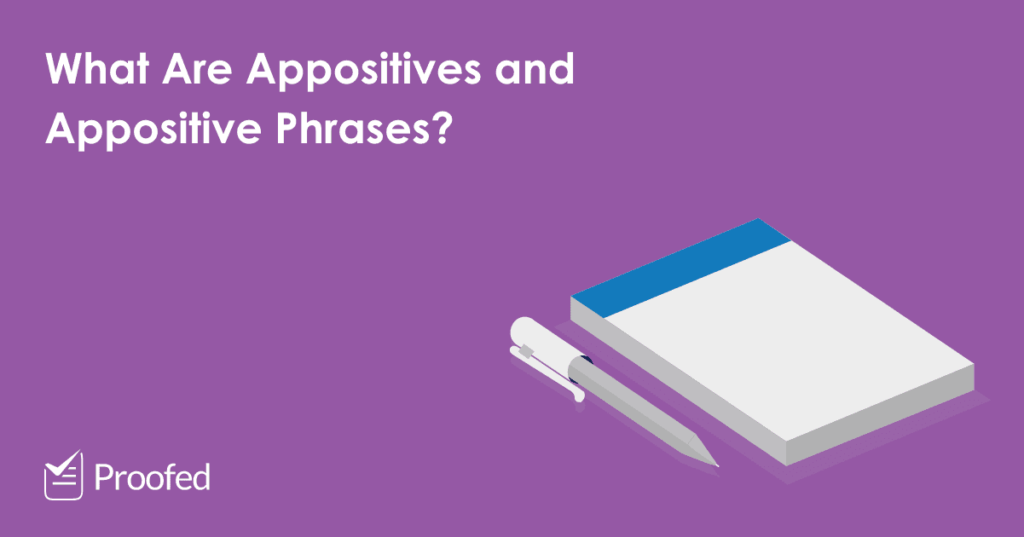Appositives and appositive phrases sound very technical, but people use them in writing and speech all the time. Read our guide below to make sure you can recognize an appositive and punctuate it correctly.
What Are Appositives and Appositive Phrases?
An appositive is a noun or noun phrase that renames, defines, or identifies another noun. In short, appositives give us more information about a noun.
This can be as little as a single word. Take the sentence below, for example:
My friend Rachel loves dogs.
Here, “Rachel” is an appositive that tells us more about the noun “friend.”
By contrast, an appositive phrase may be several words long:
A childish scream of delight that I found both terrifying and exhilarating, the noise came from upstairs.
Here, the full appositive phrase is “a childish scream of delight that I found both terrifying and exhilarating,” which tells us more about the noun “noise” in the main clause. And as you can see, in this case we have given the appositive phrase before the noun it is modifying.
We can also add an appositive at the end of a sentence:
She chose to wear a deerstalker, a hat associated with Sherlock Holmes.
Here, the appositive tells us more about the noun “deerstalker.” And as these examples show, while you have options for where to place an appositive in a sentence, it should always be next to the noun it modifies.
Punctuating Appositives
As you can see above, some appositives and appositive phrases are set apart with commas. You can also do this with dashes or brackets:
Miss Ramirez – a Harvard graduate – was pleased with the decision.
My father (who works as a chef) is very kind.
The rule for when to set apart appositives with punctuation is:
Find this useful?
Subscribe to our newsletter and get writing tips from our editors straight to your inbox.
- Do not set apart appositives that are essential to identifying a noun.
- Use punctuation to set apart non-essential information.
These are known as restrictive and non-restrictive appositives, respectively.
Restrictive Appositives (No Punctuation)
A restrictive appositive is essential to understanding the identity or meaning of a noun. Typically, this will be because it is more specific than the noun it appears alongside. For instance, we could say:
The author J. K. Rowling has published a new book.
Here, the main noun is the generic term “author.” The appositive, meanwhile, is “J. K. Rowling,” which is far more specific and tells us the identity of the author in question. And since we need the appositive here to identify the noun it modifies, we do not set it apart from the rest of the sentence.
To demonstrate, without this appositive, the sentence would say:
The author has published a new book.
This is much less helpful, as we no longer know which author the writer means! And if you cannot remove an appositive without changing the overall meaning of the sentence, you know it is restrictive.
Non-Restrictive Appositives (Set Apart with Punctuation)
A non-restrictive appositive gives us extra information about a noun, but it is not essential to understanding its identity or meaning. For example:
J. K. Rowling, the successful author, has published a new book.
Here, the appositive phrase is “the successful author.” This tells us something about J. K. Rowling, but we can easily remove it from the sentence without changing its overall meaning:
J. K. Rowling has published a new book.
And because it is non-essential, “the successful author” is non-restrictive here and we set it apart from the rest of the sentence with commas.
Summary: Appositives and Appositive Phrases
Appositives and appositive phrases sound complicated, but they are an everyday part of English. Just remember:
- Appositives are nouns or noun phrases that rename, identify, or define another noun to give us more information about it.
- Appositives can go anywhere in a sentence, but they should appear next to (either just before or just after) the noun they modify.
- If you could remove an appositive without changing the meaning of a sentence, it should be set apart with commas, dashes, or brackets.
And don’t forget that our expert editors and proofreaders are always happy to check your punctuation, grammar, or any other aspect of your writing.



